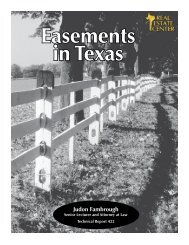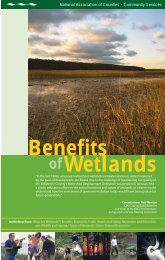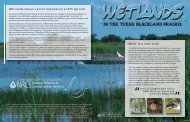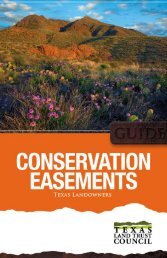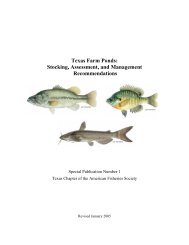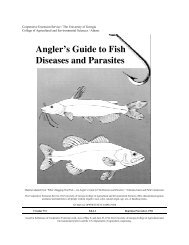Managing Yaupon with Fire and Herbicides in the ... - Trinity Waters
Managing Yaupon with Fire and Herbicides in the ... - Trinity Waters
Managing Yaupon with Fire and Herbicides in the ... - Trinity Waters
You also want an ePaper? Increase the reach of your titles
YUMPU automatically turns print PDFs into web optimized ePapers that Google loves.
<strong>Manag<strong>in</strong>g</strong> <strong>Yaupon</strong> With <strong>Fire</strong><br />
<strong>and</strong> <strong>Herbicides</strong> <strong>in</strong> <strong>the</strong> Texas<br />
Post Oak Savannah<br />
<strong>Yaupon</strong> <strong>in</strong>vasion <strong>in</strong>to historic grassl<strong>and</strong> savannahs can be effectively reduced<br />
<strong>with</strong> prescribed burn<strong>in</strong>g <strong>and</strong> herbicides.<br />
By Rob Mitchell, James C. Ca<strong>the</strong>y, Brad Dabbert, Dale F.<br />
Prochaska, Stephanie DuPree, <strong>and</strong> Ron Sosebee<br />
The Post Oak Savannah Ecological Region <strong>in</strong> Texas<br />
was once an open grassl<strong>and</strong> savannah ma<strong>in</strong>ta<strong>in</strong>ed<br />
by periodic fires. 1 The Post Oak Savannah can<br />
support mid- <strong>and</strong> tall grasses, such as little<br />
bluestem, <strong>in</strong>diangrass, Texas w<strong>in</strong>tergrass, <strong>and</strong> purpletop.<br />
Today, <strong>the</strong> savannahs have been replaced by oak woodl<strong>and</strong>s<br />
<strong>with</strong> dense yaupon (Ilex vomitoria) understories that limit<br />
grass <strong>and</strong> forb production <strong>and</strong> species diversity (Fig. 1).<br />
Restriction of fires <strong>in</strong> conjunction <strong>with</strong> poor graz<strong>in</strong>g management<br />
<strong>and</strong> periodic droughts are often credited for <strong>the</strong><br />
dense thickets that occur <strong>in</strong> <strong>the</strong> Post Oak Savannah. 2<br />
<strong>Yaupon</strong> is a native component of <strong>the</strong> Post Oak Savannah<br />
<strong>and</strong> is a slow-grow<strong>in</strong>g <strong>and</strong> erect evergreen shrub found <strong>in</strong><br />
both open areas <strong>and</strong> <strong>in</strong> <strong>the</strong> forest understory. 2–4 It can form<br />
dense thickets from its multistemmed base <strong>and</strong> reach 26 feet<br />
<strong>in</strong> height. 4 <strong>Yaupon</strong> growth beg<strong>in</strong>s <strong>in</strong> March <strong>and</strong> cont<strong>in</strong>ues<br />
through October if soil water is sufficient <strong>and</strong> grows best on<br />
sites <strong>with</strong> s<strong>and</strong>y soils <strong>and</strong> permeable subsoils. 3 <strong>Yaupon</strong> grow<strong>in</strong>g<br />
<strong>in</strong> open areas tends to produce high fruit yields dur<strong>in</strong>g<br />
alternate years. It also reproduces asexually by root or basal<br />
crown sprout<strong>in</strong>g.<br />
<strong>Yaupon</strong> is easily top-killed by burn<strong>in</strong>g, but <strong>the</strong> plant<br />
sprouts from <strong>the</strong> base, result<strong>in</strong>g <strong>in</strong> low mortality. Most burn<strong>in</strong>g<br />
<strong>in</strong> <strong>the</strong> region occurs dur<strong>in</strong>g w<strong>in</strong>ter, which provides <strong>the</strong><br />
safest conditions for burn<strong>in</strong>g. However, w<strong>in</strong>ter burn<strong>in</strong>g<br />
favors forbs <strong>and</strong> reduces grass, which may be desirable for<br />
wildlife habitat but detrimental for livestock graz<strong>in</strong>g. 5 A<br />
management plan that <strong>in</strong>corporates only w<strong>in</strong>ter burn<strong>in</strong>g<br />
usually results <strong>in</strong> f<strong>in</strong>e-fuel loads dom<strong>in</strong>ated by forbs, promot<strong>in</strong>g<br />
patchy, lower temperature burns <strong>in</strong> <strong>the</strong> future. <strong>Yaupon</strong><br />
thrives under <strong>the</strong>se conditions.<br />
Locations <strong>and</strong> Treatments<br />
Studies were conducted on <strong>the</strong> Gus Engel<strong>in</strong>g Wildlife<br />
Management Area (WMA) near Palest<strong>in</strong>e, Texas (Fig. 2).<br />
Figure 1. A dense yaupon thicket dur<strong>in</strong>g w<strong>in</strong>ter at <strong>the</strong> Gus Engl<strong>in</strong>g<br />
Wildlife Management Area near Palest<strong>in</strong>e, Texas. Some yaupon <strong>in</strong> this<br />
thicket exceeded heights of 15 feet.<br />
October 2005<br />
17
Sidebar<br />
The use of <strong>in</strong>dividual plant treatments (IPT) to control problem<br />
plants is becom<strong>in</strong>g an <strong>in</strong>creas<strong>in</strong>gly viable management<br />
alternative. 6 The suggested method for manag<strong>in</strong>g yaupon <strong>in</strong><br />
Texas is to apply an IPT of 25% Remedy (triclopyr: 3,5,6-<br />
trichloro-2-pyrid<strong>in</strong>yloxyacetic acid, butoxyethyl ester, 61.6%)<br />
<strong>in</strong> diesel fuel to wet completely around <strong>the</strong> lower 18 <strong>in</strong>ches<br />
of <strong>the</strong> trunk anytime dur<strong>in</strong>g <strong>the</strong> year. 7 However, little <strong>in</strong>formation<br />
is available for treatment options that <strong>in</strong>corporate prescribed<br />
burn<strong>in</strong>g. We <strong>in</strong>vestigated <strong>the</strong> impact of low-volume<br />
basal IPT of diesel <strong>and</strong> diesel comb<strong>in</strong>ed <strong>with</strong> Garlon 4 (triclopyr:<br />
3,5,6-trichloro-2-pyrid<strong>in</strong>yloxyacetic acid, butoxyethyl<br />
ester, 61.6%) at rates of 5%, 10%, 20%, <strong>and</strong> 25% on<br />
yaupon plants that had sprouted 6 <strong>and</strong> 18 months after prescribed<br />
burn<strong>in</strong>g. We used Garlon 4 because it is labeled for<br />
controll<strong>in</strong>g woody plants <strong>in</strong> forests <strong>and</strong> wildlife open<strong>in</strong>gs.<br />
The climate is moist subhumid, <strong>with</strong> annual precipitation of<br />
about 40 <strong>in</strong>ches <strong>and</strong> a 225-day grow<strong>in</strong>g season. 8<br />
Management units on Gus Engel<strong>in</strong>g WMA are typically<br />
burned every 3 years. We chose 2 study sites that were<br />
burned on ei<strong>the</strong>r February 15, 2000, or February 22, 2001.<br />
These areas allowed us to evaluate <strong>the</strong> use of herbicides 6 <strong>and</strong><br />
18 months after burn<strong>in</strong>g. Study sites were selected on <strong>the</strong><br />
basis of accessibility <strong>and</strong> <strong>the</strong> presence of an adequate yaupon<br />
density for evaluation. The soils on each site were dom<strong>in</strong>ated<br />
by s<strong>and</strong>y loams <strong>with</strong> slopes rang<strong>in</strong>g from 1% to 8%. 8<br />
Woody plants varied by site <strong>and</strong> <strong>in</strong>cluded post oak, s<strong>and</strong> jack<br />
oak, cedar elm, yaupon, hawthorn, dewberry, <strong>and</strong> greenbrier.<br />
At each of <strong>the</strong> burned sites, 25 yaupon plants were selected<br />
<strong>and</strong> r<strong>and</strong>omly marked for no treatment, treatment <strong>with</strong><br />
diesel only, or 5%, 10%, 20%, or 25% Garlon 4 <strong>in</strong> diesel. We<br />
Figure 2. The study was conducted on <strong>the</strong> Gus Engel<strong>in</strong>g Wildlife<br />
Management Area located <strong>in</strong> Anderson County near Palest<strong>in</strong>e, Texas.<br />
ma<strong>in</strong>ta<strong>in</strong>ed 4–6 feet between treated trees to ensure that different<br />
trees were treated. The 2000 (18 months postburn)<br />
<strong>and</strong> 2001 (6 months postburn) burned yaupon trees had to<br />
meet 2 criteria to be selected for study. First, it must have<br />
been top-killed by <strong>the</strong> fire, <strong>and</strong>, second, <strong>the</strong> sprouts had to be<br />
<strong>in</strong> <strong>the</strong> short-shoot (reproductive) growth stage. A backpack<br />
sprayer fitted <strong>with</strong> a flat-fan nozzle was used to spray <strong>the</strong><br />
basal portion of <strong>the</strong> plant, avoid<strong>in</strong>g <strong>the</strong> foliage (Fig. 3). All<br />
herbicide treatments were applied between July 16 <strong>and</strong> 20,<br />
2001. Mortality was evaluated 24 months after spray<strong>in</strong>g. All<br />
trees that had any new or liv<strong>in</strong>g leaves, new sprouts or stems,<br />
or pliable stems were considered liv<strong>in</strong>g, whereas all trees <strong>with</strong><br />
brittle stems <strong>and</strong> brown leaves were considered dead.<br />
Response to Treatments<br />
Previous observations on Gus Engel<strong>in</strong>g WMA <strong>in</strong>dicated that<br />
prescribed burn<strong>in</strong>g reduced <strong>the</strong> canopy of yaupon but did not<br />
cause mortality. However, when diesel or diesel mixed <strong>with</strong><br />
Garlon 4 was applied 6 <strong>and</strong> 18 months after burn<strong>in</strong>g, mortality<br />
did occur at high rates (Table 1). All treatments conta<strong>in</strong><strong>in</strong>g<br />
Garlon 4 resulted <strong>in</strong> at least 92% mortality.<br />
<strong>Yaupon</strong> sprouted vigorously after burn<strong>in</strong>g. Mortality due<br />
to burn<strong>in</strong>g was not evaluated s<strong>in</strong>ce <strong>in</strong>dividual trees were not<br />
marked prior to burn<strong>in</strong>g. However, yaupon has proven to be<br />
a persistent competitor for resources even after prescribed<br />
burn<strong>in</strong>g. Its strong sprout<strong>in</strong>g ability has limited <strong>the</strong> longterm<br />
control of mature plants by burn<strong>in</strong>g alone.<br />
Management Implications<br />
<strong>Yaupon</strong> is controlled <strong>with</strong> low concentrations of herbicide<br />
after prescribed burn<strong>in</strong>g. We suggest select<strong>in</strong>g <strong>the</strong> treatment<br />
on <strong>the</strong> basis of management objectives <strong>and</strong> cost. For example,<br />
to develop yaupon-free clear<strong>in</strong>gs <strong>with</strong><strong>in</strong> a forested management<br />
unit, spray<strong>in</strong>g <strong>the</strong> postfire sprouts <strong>with</strong> 10% Garlon 4 six<br />
months after burn<strong>in</strong>g resulted <strong>in</strong> 100% mortality <strong>and</strong> would<br />
cost $0.40/killed tree. If about 85% mortality is acceptable, a<br />
basal application of diesel 6 months after burn<strong>in</strong>g would<br />
reduce treatment costs to $0.20/killed tree <strong>and</strong> elim<strong>in</strong>ate <strong>the</strong><br />
need to purchase herbicides. Although apply<strong>in</strong>g 25% Garlon<br />
4 resulted <strong>in</strong> 100% mortality 6 <strong>and</strong> 18 months after burn<strong>in</strong>g,<br />
treatment cost <strong>in</strong>creases to $0.73/killed tree, more than 4<br />
times more expensive than diesel alone. It appears that apply<strong>in</strong>g<br />
herbicides <strong>with</strong> IPT 6 months after burn<strong>in</strong>g is slightly<br />
more effective than apply<strong>in</strong>g herbicides 18 months after burn<strong>in</strong>g.<br />
Plants treated 6 months after burn<strong>in</strong>g were smaller, <strong>and</strong><br />
some of <strong>the</strong> herbicide was likely applied to <strong>the</strong> foliage <strong>in</strong> addition<br />
to <strong>the</strong> plant bases, likely flood<strong>in</strong>g <strong>the</strong> plant system <strong>with</strong><br />
herbicide. Prescribed fire alone will not reduce yaupon density<br />
<strong>and</strong> restore <strong>the</strong> flora <strong>and</strong> fauna of <strong>the</strong> Post Oak Savannah.<br />
<strong>Yaupon</strong> can be readily controlled <strong>in</strong> most situations. We<br />
have provided several alternatives for manag<strong>in</strong>g yaupon after<br />
burn<strong>in</strong>g. Prescribed fire application at 5- to 7-year <strong>in</strong>tervals<br />
<strong>and</strong> monitor<strong>in</strong>g habitat to respond to yaupon <strong>in</strong>vasions early<br />
will reduce <strong>the</strong> negative effects of yaupon. If yaupon is permitted<br />
to become too dense before burn<strong>in</strong>g, grass production<br />
18 Rangel<strong>and</strong>s
Table 1. <strong>Yaupon</strong> mortality (%) 24 months after treatment <strong>with</strong> diesel or diesel <strong>and</strong> four concentrations (5,<br />
10, 20, <strong>and</strong> 25%) of Garlon 4. Study sites at <strong>the</strong> Gus Engel<strong>in</strong>g Wildlife Management Area near Palest<strong>in</strong>e,<br />
Texas, were burned dur<strong>in</strong>g w<strong>in</strong>ter <strong>in</strong> 2000 <strong>and</strong> 2001, <strong>and</strong> herbicide treatments were applied <strong>in</strong> summer 2001,<br />
6 or 18 months after burn<strong>in</strong>g. Costs per treated plant are based on <strong>the</strong> follow<strong>in</strong>g assumptions: diesel cost<br />
= $2.05/gallon; Garlon 4 cost = $113/gallon; labor cost = $13/hour; 100 trees were treated/hour; each tree<br />
received 2.6 oz. of mixture for each treatment.<br />
6 Months post-burn<br />
18 Months<br />
post-burn<br />
Cost/plant<br />
Garlon 4 concentration (%) Mortality (%) $/treated ($/killed)<br />
Diesel only - 0 84 60 0.17 (0.20-0.28)<br />
5 96 92 0.28 (0.29-0.30)<br />
10 100 92 0.40 (0.40-0.43)<br />
20 100 96 0.62 (0.62-0.65)<br />
25 100 100 0.73 (0.73)<br />
will be limited, reduc<strong>in</strong>g <strong>the</strong> ability to safely apply prescribed<br />
fire <strong>and</strong> reduc<strong>in</strong>g <strong>the</strong> graz<strong>in</strong>g value <strong>and</strong> wildlife habitat quality<br />
of <strong>the</strong> site.<br />
Authors are Rangel<strong>and</strong> Scientist, USDA-ARS, L<strong>in</strong>coln, Nebraska<br />
(Mitchell); Assistant Professor, Texas A&M University Texas<br />
Agricultural Experiment Station, Uvalde, Texas (Ca<strong>the</strong>y);<br />
Associate Professor (Dabbert) <strong>and</strong> Professor (Sosebee), Texas Tech<br />
University, Lubbock, Texas; Wildlife Biologist, Texas Parks <strong>and</strong><br />
Wildlife Department, Kerr Wildlife Management Area, Hunt,<br />
Texas (Prochaska); <strong>and</strong> GIS Analyst, Halff Associates, Inc., Fort<br />
Worth, Texas (DuPree). This paper is a jo<strong>in</strong>t contribution of <strong>the</strong><br />
USDA-ARS, Texas A&M University, <strong>and</strong> Texas Tech University.<br />
Figure 3. <strong>Yaupon</strong> be<strong>in</strong>g treated <strong>with</strong> basal herbicide applications 18<br />
months after burn<strong>in</strong>g. The plant was top-killed by burn<strong>in</strong>g <strong>and</strong> sprouted<br />
from <strong>the</strong> base, result<strong>in</strong>g <strong>in</strong> numerous stems per plant.<br />
Mention of trade names or commercial products <strong>in</strong> this publication<br />
is solely for <strong>the</strong> purpose of provid<strong>in</strong>g specific <strong>in</strong>formation <strong>and</strong><br />
does not imply recommendation or endorsement by <strong>the</strong> U.S.<br />
Department of Agriculture, Texas A&M University, Texas Tech<br />
University, or <strong>the</strong> University of Nebraska. Always read <strong>and</strong> follow<br />
label directions.<br />
References<br />
1. AXELROD, D. I. 1985. Rise of <strong>the</strong> grassl<strong>and</strong> biome, central<br />
North America. Botanical Review 51: 163–201.<br />
2. SCIFRES, C. J. 1980. Brush management. College Station, TX:<br />
Texas A&M University Press. 360 p.<br />
3. HALLS, L. K. 1977. Sou<strong>the</strong>rn fruit-produc<strong>in</strong>g woody plants<br />
used by wildlife. New Orleans, LA: USDA Forest Service,<br />
Sou<strong>the</strong>rn Forest Experimental Station, General Technical<br />
Report SO-16. 235 p.<br />
4. VINES, R. A. 1960. Trees, shrubs, <strong>and</strong> woody v<strong>in</strong>es of <strong>the</strong><br />
Southwest. Aust<strong>in</strong>, TX: University of Texas Press. 1104 p.<br />
5. GARZA, N. E., JR., AND W. H. BLACKBURN. 1985. The effect<br />
of early w<strong>in</strong>ter or spr<strong>in</strong>g burn<strong>in</strong>g on runoff, sediment, <strong>and</strong> vegetation<br />
<strong>in</strong> <strong>the</strong> Post Oak Savannah of Texas. Journal of Range<br />
Management 38:283–287.<br />
6. MITCHELL, R., S. WHISENANT, AND R. SOSEBEE. 2004. A paradigm<br />
shift. In: W. Hamilton et al. [eds.]. Brush management:<br />
Past, present, future. College Station, TX: Texas A&M<br />
University Press. p 67–75.<br />
7. MCGINTY, A., J. F. CADENHEAD, W. HAMILTON, W.<br />
HANSELKA,D.UECKERT, AND S. WHISENANT. 2000. Chemical<br />
weed <strong>and</strong> brush control suggestions for rangel<strong>and</strong>. College<br />
Station, TX: Texas A&M University. Texas Agricultural<br />
Extension Service Publication B-1466. p 13.<br />
8. U.S. DEPARTMENT OF AGRICULTURE. 1975. Soil Survey of<br />
Anderson County, Texas. Wash<strong>in</strong>gton, DC: Soil Conservation<br />
Service.<br />
October 2005<br />
19



